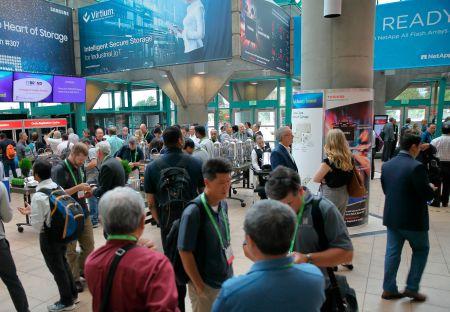This week is the 14th annual Flash Memory Summit, a conference focused on memory.
In terms of storing a given amount of memory, flash memory is (as of this writing) still more expensive than hard drives—but that’s where the hard drive’s advantages end. SSDs (solid-state drives) built with flash memory are more rugged, smaller, and less power-hungry than their mechanical predecessors.
Even more critical for many applications, access to data is far faster. This is a critical factor for cloud-based AI, gaming, mobile devices, and smart car applications, where latency issues cannot be tolerated.
As is the case for all electronic components, flash memory does not exist in a vacuum and must be interconnected with the rest of the system. For this reason, the latest advances and standards for memory busses will also be a hot topic this year.

Image from Flash Memory Summit
This year's Flash Memory Summit 2019 (hosted in Santa Clara, CA) has featured a series of advancements in memory, including Toshiba Memory's XFMEXPRESS NVMe technology, which was just crowned "Best in Show" for the conference.
Here's a quick look at what FMS 2019 has to offer in its programming.
The Demands of AI and 5G
As described in Tom Coughlin’s IEEE article, “Storage and Memory Infrastructure to Support 5G Applications,” 4G provides data rates of 100 Mbps tops, while 5G will blast along 50 times faster at 10 Gbps. In addition, 5G for smart cars can tolerate a latency of no more than 1 ms. It’s for this reason that solid-state storage and will provide the road to the high-speed, low-latency future.
Samsung also enumerates the enormous demands that 5G and AI will make of memory systems in its Tech Leadership 5G and Memory - from Connected Thinking to Connected Living article. They detail their HBM2 LPDDR5 and LPDDR4x memories, as well as their 8TB NVMe NF1 SSD, optimized for data-intensive analytics and virtualization applications. The device is built with 16 of Samsung’s 512GB NAND packages, each stacked in 16 layers of 256Gb, 3-bit V-NAND chips, achieving an 8TB density in a footprint of 11 centimeters (cm) x 3.05cm.
5G itself would not be possible without the memory innovations that will be introduced and discussed at the Flash Memory Summit.
2019 Keynotes
The most interesting part of any conference is the keynote addresses, and this year’s Flash Memory Summit will be no exception.
This year's keynotes address topics such as 4D memories and the advanced NVMe pathways that will enable systems developers to fully exploit them in applications such as AI and 5G. Here, latency cannot be tolerated. Indeed in last years conference, SSDs were be seen as adjuncts to hard drives. Now, they are presented as essential in themselves to progress in advanced systems.
Here are a few of this year’s keynote discussions:
"Meeting Application Needs with a New Generation of Advanced Storage Technology" by Shigeo (Jeff) Ohshima and Jeremy Werner of Toshiba
Real-time analytics, AI/ML, IoT, virtual and augmented reality in relation to their dependence on further developments in new flash architecture and further progress in NVMe SSDs.
"Data-centric Architecture for the Zettabyte Age" by Dr. Siva Sivaram and Christopher Bergey of Western Digital
A petabyte is two to the seventieth (250) bits, while a zetabyte is a staggering two to the seventieth (270) bits. To manage this astronomical amount of data, even the new quad-layer-cell (QLC) technology and other advanced memory types will require a new data-centric systems architecture.
"4D NAND: The New Leader in Flash" by Hongsok Choi and Andrew (Hyonil) Chong of SK hynix
3D NAND cannot fully meet the demands of cloud providers and new technologies such as 5G, AI, and IoT. A “fourth dimension” is made possible by the use of use charge trap flash (CTF) and periphery under cell (PUC) technologies. 4D NANDs in combination with the new high-performance interfaces are the key to progress.
"Leveraging Flash Memory for High-Performance AI" by Steven Eliuk of IBM
Data management architecture is necessary for effective AI
"Breakthrough Data-Centric Computing with a New Memory Tier" by Alper Ilkabahar of Intel
Progress in data-centric workloads, such as real-time analytics, AI/ML, VR/AR, IoT, HPC, and cybersecurity, demand tremendous throughput at a reasonable price. Beyond the existing storage hierarchy of DRAM and flash, yet a new memory tier will be needed. Already available use cases will be discussed.
Are you attending this year's FMS? Have you been to previous events? Share your thoughts on how this conference impacts the industry!

No comments:
Post a Comment